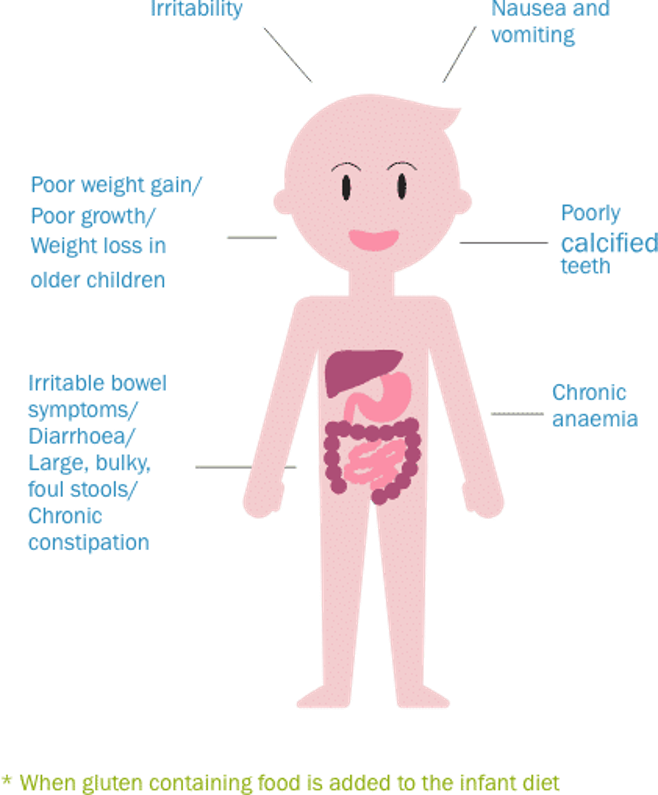The nurse notes on assessment that a 1-year-old child underweight with abdominal distention, thin legs and arms, and foul-smelling stools. The nurse suspects failure to thrive is associated with
Intussusception
imperforate anus
celiac disease
table bowel syndrome
The Correct Answer is C
Celiac disease is an autoimmune disorder triggered by the ingestion of gluten, a protein found in wheat, barley, and rye. It causes damage to the lining of the small intestine, leading to malabsorption of nutrients. The characteristic symptoms of celiac disease include abdominal distention, underweight or failure to thrive, thin arms and legs, and foul-smelling stools.
intussusception in (option A) is incorrect because it, refers to a condition where a portion of the intestine telescopes into an adjacent section, causing an obstruction. While intussusception can present with symptoms such as abdominal pain, vomiting, and currant jelly-like stools, it is not typically associated with failure to thrive.
imperforate anus, in (option B) is incorrect because it is a congenital condition in which the opening of the anus is blocked or absent. It can cause difficulties with passing stools, but it is not typically associated with failure to thrive or the specific assessment findings described.
irritable bowel syndrome (IBS) in (option D) is incorrect because it, is a chronic disorder of the gastrointestinal tract characterized by recurrent abdominal pain, changes in bowel habits, and bloating. While IBS can cause gastrointestinal symptoms, it is not typically associated with failure to thrive, underweight, or the specific assessment findings mentioned.

Nursing Test Bank
Naxlex Comprehensive Predictor Exams
Related Questions
Correct Answer is B
Explanation
Juvenile arthritis should be suspected in a child who exhibits joint swelling and pain lasting
longer than 6 weeks. Juvenile arthritis refers to a group of chronic inflammatory conditions
that affect the joints in children and adolescents. Persistent joint swelling and pain are
common symptoms of juvenile arthritis and are often accompanied by other signs such as
morning stiffness, limited range of motion, and joint warmth.
, frequent fractures in (option A) is not correct because it, is not typically associated with
juvenile arthritis. Fractures are more commonly associated with conditions affecting bone
strength, such as osteoporosis or certain genetic disorders.
lurching and abnormal gait with limited abduction in (option A) is not correct because it,
may be seen in certain musculoskeletal conditions or hip joint abnormalities, but it is not
specific to juvenile arthritis.
increased joint mobility in (option D) is incorrect because it, is not typically associated with
juvenile arthritis. In fact, joint stiffness and limited range of motion are more characteristic of
this condition.
Correct Answer is B
Explanation
Precocious puberty is defined as the onset of puberty before the age of 8 in girls and before the age of 9 in boys. However, it is important to note that the exact age at which puberty is considered precocious can vary slightly based on different guidelines and individual variations.
Boys: 11 years; girls: 9 years in (option A) is incorrect because it, is close to the general age range, but it is slightly earlier than what is commonly considered precocious puberty.
Boys: 10 years; girls: 9 1/2 years in (option C) is incorrect because it, is also close to the general age range, but it is not as commonly recognized as the age for precocious puberty.
Boys: 9 years; girls: 8 years in (option D) is incorrect because it, is significantly earlier than the usual age for precocious puberty. Puberty occurring at this age would be considered very early and may warrant further evaluation.
Whether you are a student looking to ace your exams or a practicing nurse seeking to enhance your expertise , our nursing education contents will empower you with the confidence and competence to make a difference in the lives of patients and become a respected leader in the healthcare field.
Visit Naxlex, invest in your future and unlock endless possibilities with our unparalleled nursing education contents today
Report Wrong Answer on the Current Question
Do you disagree with the answer? If yes, what is your expected answer? Explain.
Kindly be descriptive with the issue you are facing.

